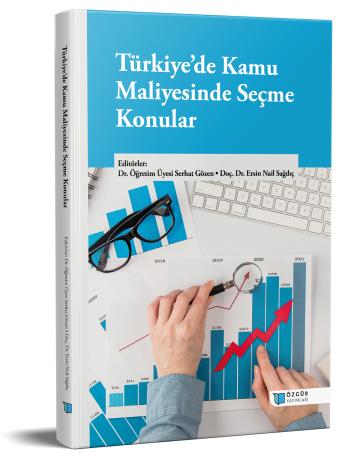
Türkiye’de Kamu Maliyesinde Seçme Konular
İndir
Özet
Türkiye’de Kamu Maliyesi alanındaki gelişmelerin ele alındığı kitabımız, Kütahya Dumlupınar Üniversitesi Maliye Bölümü öğretim elemanları tarafından hazırlanan on bölümden oluşmaktadır. Kitapta, Türkiye’de son yıllarda yaşanan ekonomik ve mali olayların kapsamlı bir şekilde incelenmesi amaçlanmıştır. Bu çerçevede kitapta yer alan bölümlere ilişkin özetlere aşağıda yer verilmektedir.
Çalışmanın birinci bölümünde Abdullah Burhan Bahçe ve Ezgi Bahçe, dünyada ve Türkiye’de turizme uygulanan konaklama vergisi türleri, sınıflandırılmaları ve oranları ile vergi gelirlerinin nasıl kullanılacağı gibi temel bilgileri ülke ve şehir örnekleri üzerinden değerlendirilmişlerdir. Dünya ve Türkiye karşılaştırmalarının yapıldığı bu çalışmanın sonucunda Türkiye’de uygulanan konaklama vergisine ek olarak, İstanbul ve Antalya gibi şehirlerde ekstra şehir vergisi uygulamalarına ilişkin öneriler sunulmuştur.
Çalışmanın ikinci bölümünde Berna Hızarcı Beşer ve Canan Çetil, teknokentler, teknokentlerin başarı ölçütleri ve teknokentlere yönelik vergi uygulamalarını incelemişlerdir. Çalışmada Teknoparklara yönelik vergi uygulamalarının düzenlenmesiyle ihtiyaç duyulan Ar-Ge yatırımlarının artacağı öngörülmektedir.
Ebru Yalçın ve İlter Ünlükaplan tarafından hazırlanan üçüncü bölümde, Avrupa Birliği üyesi ülkeler ile Birleşik Krallık’ta yer alan bağımsız mali kurumların yapısı incelenerek mali yönetişimin sağlanmasındaki katkılar ortaya konulmuştur. Değerlendirmeler ışığında, bağımsız mali kurumlar ile mali kuralların tamamlayıcı bir ilişki gösterdiği, mali yönetişim anlayışının tüm araçların kapsayıcı politikalarla bir araya getirilmesiyle daha iyi sonuçlar verdiği sunucuna ulaşılmıştır.
Dördüncü bölümde Ebru Yalçın, 2006-2023 yılları arasında Türkiye’de transfer harcamaları ve sosyal yardımlar ile gelir dağılımı arasındaki ilişkiyi incelemiştir. Çalışma da elde edilen bulgulara göre transfer harcamalarından gelir dağılımına doğru tek yönlü nedensellik ilişkisi olduğunu tespit edilmiştir.
Beşinci bölüm yazarları Meltem Burcu Durmuş ve Güner Tuncer, mükellef tipolojilerinin belirlenmesine yönelik bir analiz gerçekleştirmişlerdir. Çalışma vergi mükelleflerinin, vergi uyumu veya uyumsuzluğu sonucunda oluşan mükellef tiplerinin hangisinde kendilerini konumlandırdıklarını tespit etmek ve bu durumu nasıl algıladıklarını belirlemek amacıyla nitel analiz yöntemi ile gerçekleştirilmiştir. Elde edilen bulgular ışığında, vatandaşlık görevi bilinci, vergi adaletinin güçlü olması, vergi otoritesinin olumlu davranışları, ülke ekonomisindeki olumlu gelişmeler ve vatandaşların gelir düzeylerine ve mükelleflerin yaşam kalitesine yansıması, mükelleflerin dürüst (gönüllü) mükellef tipolojisinde yer almasını sağlayabileceği sonucuna varılmıştır.
Altıncı bölümde Hasan Hüseyin Aleçakır ve Gülistan Altıok, Türkiye’de ve dünyada seçilmiş ülkelerde Dijital Hizmet Vergisi uygulamalarını incelemişlerdir. Çalışmada Dijital Hizmet Vergisi’nin tarihi ile seçilmiş ülkelerde Dijital Hizmet Vergisi uygulamalarını ele almışlardır.
Yedinci bölümde Hakan Kaçar ve Hatice Dayar, Türkiye ve seçilmiş ülkelerde karşılaştırmalar yaparak Sayıştay denetimini incelemişlerdir. Fransa, Almanya, İngiltere, Avrupa Birliği ve Amerika’da yüksek denetim faaliyetlerini gerçekleştiren kurumların organizasyon yapıları, faaliyetleri ve görevleri karşılaştırılmıştır. Karşılaştırmalar sonucunda çeşitli benzerlikler ve farklılıklar tespit edilip öneriler sunulmuştur.
Özcan Erdoğan sekizinci bölümde Türkiye’de işletme biçimlerini belirleyen yasalarla mali düzeni belirleyen yasalar arasındaki uyum sorunlarının şahıs şirketleri ve sermaye şirketlerinin oluşması aşamasına olan etkilerini incelemiştir. Sermaye şirketlerinin şahıs şirketlerine göre avantajlı olduğu sonucuna ulaşmıştır.
Dokuzuncu bölümde Serhat Gözen ve Ersin Nail Sağdıç, Türkiye’de 1990-2023 yılları arasında kamu dış borçları ve kamu harcamaları arasındaki ilişkiyi incelemişlerdir. Araştırma sonuçları, kamu harcamalarında meydana gelen %1'lik bir değişim uzun vadede kamu dış borcunda %0,23'lük pozitif bir değişime neden olduğunu, aynı zamanda kamu harcamaları ile kamu dış borcu arasında çift yönlü bir nedensellik ilişkisinin varlığını göstermiştir.
Onuncu bölümde Tuba Gezer, kuruluşundan bu yana Türkiye Cumhuriyeti’nin dış borç politikasını ve sonuçlarını ele almıştır. Çalışmada öncelikle devlet borçlanmasının teorik yönleri, dış borç kavramı, dış borç türleri ve nedenlerine değinilmiştir. Diğer taraftan Türkiye'de dış borçların gelişimi Cumhuriyet dönemi (1923-1946), Planlı Kalkınma öncesi dönem (1946-1960), Planlı Kalkınma dönemi (1960-1980), 1980-2000 ve 2000'den günümüze kadar ayrı ayrı değerlendirilmiştir.

